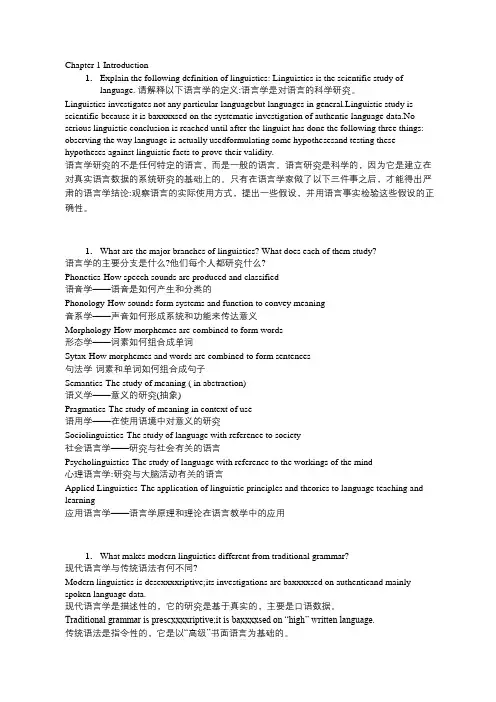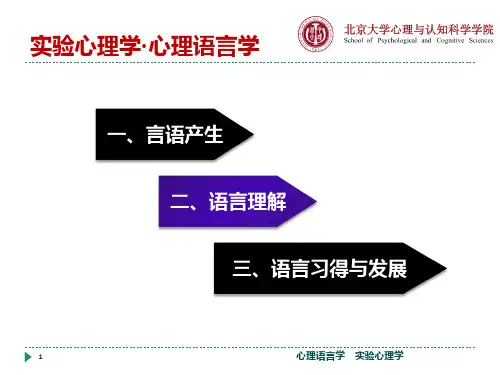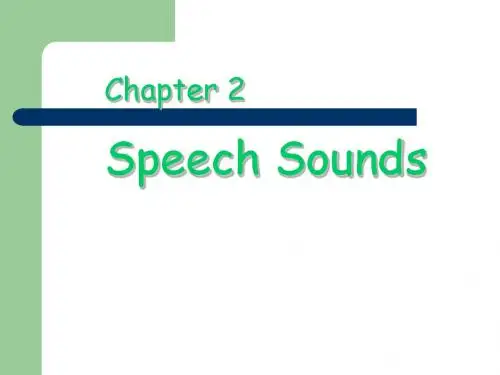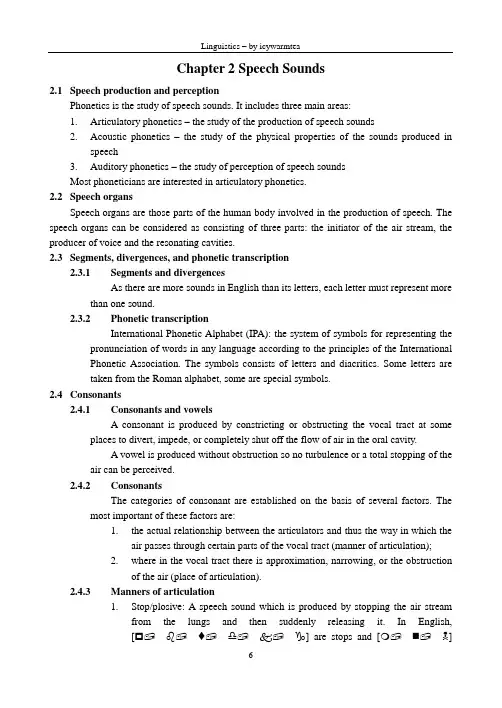心理语言学chapter 2
- 格式:ppt
- 大小:1.01 MB
- 文档页数:48

Chapter 1 Introduction1.Explain the following definition of linguistics: Linguistics is the scientific study oflanguage. 请解释以下语言学的定义:语言学是对语言的科学研究。
Linguistics investigates not any particular languagebut languages in general.Linguistic study is scientific because it is baxxxxsed on the systematic investigation of authentic language data.No serious linguistic conclusion is reached until after the linguist has done the following three things: observing the way language is actually usedformulating some hypothesesand testing these hypotheses against linguistic facts to prove their validity.语言学研究的不是任何特定的语言,而是一般的语言。
语言研究是科学的,因为它是建立在对真实语言数据的系统研究的基础上的。
只有在语言学家做了以下三件事之后,才能得出严肃的语言学结论:观察语言的实际使用方式,提出一些假设,并用语言事实检验这些假设的正确性。
1.What are the major branches of linguistics? What does each of them study?语言学的主要分支是什么?他们每个人都研究什么?Phonetics-How speech sounds are produced and classified语音学——语音是如何产生和分类的Phonology-How sounds form systems and function to convey meaning音系学——声音如何形成系统和功能来传达意义Morphology-How morphemes are combined to form words形态学——词素如何组合成单词Sytax-How morphemes and words are combined to form sentences句法学-词素和单词如何组合成句子Semantics-The study of meaning ( in abstraction)语义学——意义的研究(抽象)Pragmatics-The study of meaning in context of use语用学——在使用语境中对意义的研究Sociolinguistics-The study of language with reference to society社会语言学——研究与社会有关的语言Psycholinguistics-The study of language with reference to the workings of the mind心理语言学:研究与大脑活动有关的语言Applied Linguistics-The application of linguistic principles and theories to language teaching and learning应用语言学——语言学原理和理论在语言教学中的应用1.What makes modern linguistics different from traditional grammar?现代语言学与传统语法有何不同?Modern linguistics is descxxxxriptive;its investigations are baxxxxsed on authenticand mainly spoken language data.现代语言学是描述性的,它的研究是基于真实的,主要是口语数据。

第二言语产出的心理语言学分析0. 引言Levelt (1989)第一次系统考察了说话的复杂过程,提出了母语的言语产出模型。
后在新的心理语言学研究成果的基础上,Levelt (1999)提出修改的母语产出模型(参见缪海燕、刘春燕2013).他认为语言产出是模块的,即系统中某些加工成分的功能相对自足,它们有自己特定的输入,并独立于其他成分处理该输入。
该模型主要是词汇驱动的模块的语言产出过程模型,为我们研究第二言语(简称为二语)产出提供了心理语言学基础。
de Bot 和Kormos 等人分别在Levelt 模型的基础上提出了二语产出模型。
本文以母语产出和二语产出的对比为基础,首先介绍3 个二语产出模型,然后对二语产出中最重要的特征---控制,进行综述,最后对二语产出的影响因素及个体差异进行分析,从而得出相关结论。
1. 二语产出模型1. 1 de Bot 的双语产出模型(binlingual production model)de Bot (1992,2004)在Levelt (1989)的母语产出模型基础上研究了双语产出模型。
他认为双语产出模型是个默认系统,一个人使用该系统时总是只用其中一种语言。
这样,双语产出模型与单语产出模型没有本质的区别。
Levelt (1989)的产出模型将概念系统与语言系统分开且有 3 个储存器:概念形成器(conceptulizer)、话语形成器(formulator)和发音器(ar-ticulator).与该模型的假设相一致,de Bot (1992,2004)设定一个共用的概念形成器,负责语言的选择并形成用所选语言进行表达的信息。
de Bot 还遵循双语词汇系统的理论假设,在双语产出模型中采用了词库的子系统假设。
一个词库包含两种语言专用的子词库。
他设定两个话语形成器以容纳两个词库,每一个形成器都包含两种语言专用的形态句法信息。
他还提出发音器的扩展系统,认为双语者通常说第二语言时会有外国口音,因为两种语言共用一个发音器。



教案(首页)教案填写说明:①教材和主要参考资料要求表明教材或参考文献的名称、作者、出版社和出版时间。
②教学方法、手段指使用直观教具、挂图、板图、多媒体教学及双语教学等方法。
③教学进程内容包括课堂教学内容、教学方法、辅助手段、师生互动、时间分配、板书设计和作业布置等。
④板书设计可在教学进程中直接用横线、浪线等标示出来。
⑤教后感是对本次教学过程中自我感觉成功的地方以及存在的不足和学生反馈的信息情况进行总结。
课程名称:课程类型:第次课 3 学时:上课日期:1、Contents:Chapter 2: Phonetics: the study of speech soundsT eaching aims: let the students have the general idea about phonetics and phonology.Focal points: description of consonants and vowels; basic knowledge about phonologyT eaching difficulties: phoneme; allophone; minimal pair; complementary distribution2、Teaching Objectives: let the students have the general idea about phoneticsLet the students understand the system of the articulatory apparatusLet the students know how to describe consonants and vowels3、Teaching importances: description of consonants and vowels;Teaching difficulties: manners and places of articulation:I.Phonetics: is the scientific study of speech sound. It is mainly concerned with how each speech sounds is articulated and what phonetic features it has.II.Speech organs:①The oral cavity②The nasal cavity③The pharynxSee the Figure 2.1 the articulatory apparatus( page 15)课程名称:课程类型:第4次课学时:上课日期:1、Contents:Chapter 2: Phonetics: the study of speech soundsT eaching aims: let the students have the general idea about phonetics and phonology.Focal points: description of consonants and vowels; basic knowledge about phonologyT eaching difficulties: phoneme; allophone; minimal pair; complementary distribution2、Teaching Objectives: let the students have the general idea about phoneticsLet the students understand the system of the articulatory apparatusLet the students know how to describe consonants and vowels3、Teaching importances: description of consonants and vowels;Teaching difficulties: manners and places of articulationIII.Classification of speech soundsEgressive sounds: produced by pushing the air stream out of the glottis, all English sounds and Chinese sounds.Ingressive sounds: by sucking the air in.A consonant is a sound produced by an obstruction or blocking of the airflow coming out from the two lungs and then going out through the oral or nasal cavity.A vowel is produced with the vibration of the two vocal cords but with no closure or obstruction when the air stream passes through the mouth.. Classification of consonants:1. V oicing2. Places of articulation (position or place of the obstruction of the air flow)3. Manners of articulation.1.Voiceless consonants:are those that are produced when the vocal cords are apart and the airflow passes freely through the vocal tract.Voiced consonants:are those that are produced when the vocal cords are together and the airstream forces its way through the two vocal cords and caused the vibrate.Whispering is invariably voiceless.* The binary system of description:[+voiced]: [b][d][g][-voiced]: [p][t][k]2.Places of articulationLabials:Bilabials :[p] [b] [m]Labiodentals: [f][v]Labiovelars: [w][M] [ ]Interdentals: [][]Alveolars: [t][d][n][s][z][l][r]Palatals: [ ][ ][ ][ ][j]Velars: [k][g][]Glottal: [h]3.Manners of articulationStopsBilabial stopsAlveolar stopsVelar stopsAspirationpin spin怕爸他搭喀嘎fricativesLabiodental fricativesInterdental fricativesAlveolar fricativesPalatal fricativesGlottal fricativeAffricates:Liquids:[l] The front of the tongue makes contact with the alveolar ridge, but the sidesof the tongue are down and the air can escape laterally through the two sides of the tongue. It is called a lateral.[r] It is formed with the tongue tip raised and curled back behind the alveolar ridge, it is called a retroflex.Glides:Nasals:Classification of vowelsmonophthongs diphthongs triphthongsDescription of simple vowels1.The part of the tongue involvedhat hut heart2.The height of the tongueFeet fit fetch fat3.The state of the musclesTense vowels: long vowels and diphthongsLax vowels: short vowels4.The shape of lipsRounded vowels:Unrounded vowels:DiphthongsCentering diphthongs: (from the front or back to the center)Rising /closing diphthongs: ( from a lower vowel to a higher one)IV Phonetic features and natural classesSounds can be analyzed into their phonetic features[u] has the features: [+high] [-back] [+round] [-tense]Classes of sounds that share a feature or features are called natural classes. [+anterior] (a feature to specify consonants) bilabials, labiodentals, interdentals and alveolar, but not labiovelars.[+continuant] : fricatives, liquids, glides.[+sibilant]( [+strident]): are produced with a hissing noise, and they are called sibilants.[+sonorant]: vowels, glides, liquids and nasals[+syllabic]: vowels and [m] [ n] [l ]V. The IPADid he believe that Caesar could see the people seize the seas? 1888, The International Phonetic AssociationThe latest version revised in 1993 and updated in 1996The broad phonetic transcription transcribes only the sounds that contrast words in meaning.The narrow phonetic transcription provides minute differences in producing sounds.Symbols in IPA and those in American EnglishExercises:1.Fill in the following blanks1).Human communication usually takes place in the form of __________-communication and ___________communication.2).The medium of spoken language is __________.3).___________phonetics is the primary concern in linguistics.4).___________phonetics focuses on the perception of speech sounds.5).Speech organs are composed of three parts, the pharyngeal cavity, the________cavity, and __________cavity.6).The International Phonetic Transcription was devised in the year_______and has undergone several revisions.2. Write the sound which corresponds to each of the following phonetic descriptions.1).Lateral liquid2).Lax high back vowel3).V oice bilabial oral stop4).Mid central lax vowel5).V oiceless labiodental fricative6).Low front vowel7).Palatal glide8).V oice interdental fricative9).V oiced affricate10).V elar nasal consonant11).V oiceless alveolar fricative12).Aspirated bilabial stop13).High front tense unrounded vowel14).Low back vowel15).High back tense vowel16).Mid back lax vowe5、References: 《语言学概论》杨忠高等教育出版社;《新编简明英语语言学教程》戴伟栋何兆熊上海外语教育出版社;《语言学导论论》陈林华吉林大学出版社;《语言学教程》胡壮麟北京大学出版社( 必读书籍)6、Summary after teaching: It is difficult for the students to understand the meta functions of language. I should make a further study for this part.一、双音节词一般地说,一个单词中有几个发音的元音字母,就有几个音节。


语言学chapter2Chapter 2 phonology1,what are the two major media of communication? Of the two, which one is primary and why?The two major media of communication are speech and writing. Speech is more basic than writing. Because the writing system of any language is always “invented” by its users to record speech when the need arises, and in everyday communication, speech plays a greater role than writing in terms of the amount of information conveyed, speech is always the way in which every native speaker acquires his mother tongue, and writing is learned and taught later when he goes to school.2.What is voicing and how is it caused?Vibration of the vocal cords results in a quality of speech sounds that is called voicing. It is caused by vocal cords which may also be held together tightly so that the air stream vibrates hem at different speeds .3.Explain with examples how broad transcription and narrow transcription differ.Broad transcription is the transcription with letter-symbols only. Narrow transcription is the transcription with letter-symbols together with the diacritics,which are added to the letter-symbols to bring out the finer distinctions than the letters alone can possible do. For example, in broad transcription, the symbol[l]is used for the sound[l]in the four words leaf[li:f],feel[fi:l], build[bild],and health[helθ]. As a matter of fact, the sound [l]in all these four sound combination differ slightly. The [l]in[li:f], occurring before a vowel, is called clear[l], and no diacritic is need to indicate it; the [l]in[fi:l]and[bild]occurring at the end of a word or before another consonant, is pronounced differently from the clear [1] as in “leaf”. It is called dark [?] and innarr ow transcription the diacritic [?] is used to indicate it. Then in the sound combination [helθ], the sou nd [l] is followed by the English dental sound [θ], its pronunciation is somewhat affected by the dental sound that follows it. It is thus called a dental [l], and in narrow transcription the diacritic [、] is used to indicate it. It is transcribed as [helθ]. Another example is the consonant [p]. In the word pit, the sound [p] is pronounced with a strong puff of air, but in spit the puff of air is withheld to some extent. In the case of pit, the [p] sound is said to be aspirated and in the case of spit, the [p] sound is unaspirated. This difference is not shown in broadtranscription, but i n narrow transcription, a small raised “h” is used to show aspiratio n, thus pit is transcribed as [ph?t] and spit is transcribed as [sp?t].4.How are the English consonants classified?English consonants can be classified in two ways: one is in terms of manner of articulation and the other is in terms of place of articulation. In terms of manner of articulation the English consonants can be classified into the following types: stops, fricatives, affricates, liquids, nasals and glides. In terms of place of articulation, it can be classified into following types: bilabial, labiodental, dental, alveolar, palatal, velar and glottal.5.What criteria are used to classify the English vowels?Vowel sounds are differentiated by a number of factors: the position of the tongue in the mouth , the openness of the mouth, the shape of the lips, and the length of the vowels. According to which part of the tongue is held highest, vowels may bedistinguished as front, central, and back. And according to the openness of the mouth, vowels can be classified into close vowels, semi-close vowels , semi-open vowels and open vowels. According to the shape of the lips, all the front vowels and the central vowels are unrounded vowels, and all the back vowels, with the exception of[a:],are rounded vowels. According to the length of the sound, vowels can be classified into tense and lax vowels.6. Give the phonetic symbol fro each of the following sound descriptions:(1)voiced palatal affricate:[?] (2)voiceless labiodental fricative:[f](3)voiced alveolar stop: [d] (4)front, close, short: [i](5)back, semi-open, long: [?:] (6)voiceless, bilabial stop: [p]Give the phonetic features of each of the following sounds:(1)[d]: voiced alveolar stop (2)[l]: voiced alveolar liquids(3)[?]: voiceless palatal affricate (4) [w]: voiced bilabial glides(5) [?]: back, close, short (6) [?]: front, open, short7. How do phonetics and phonology differ in their focus of study? Who do you think will be more interested in the difference between, say, [l] and [?], [ph] and [p], a phonetician or a phonologist? Why?Phonetics is of a general nature, it is interested in all the speech sounds used in all human languages. Phonology aims to discover how speech sounds in a language form patterns and how these sounds are used to convey meaning in linguistic communication.The difference between these sounds is what the phonetician are interested in. Because phonology is concerned with the sound system of a particular language, but phonetician isinterested in how they are produced, how they differ from each other, what phonetic features they possess.8. What is a phone? How is it different from a phoneme? How are allophones related to a phoneme?A phone is a phonetic unit or segment. The speech sounds we hear and produce during linguistic communication are all phones. A phoneme is a phonological unit, it is a unit that is of distinctive value. It is an abstract unit. It is not particular sound, but rather it is represented or realized by a certain phone in a certain phonetic context. Allophones are the different phones which can represent a phoneme in different phonetic environments.9. Explain with examples the sequential rule, the assimilation rule, and the deletion rule.Sequential rules refer to the ways the phonemes can be combined. Sequential rules regulate which phonemes can begin a word, end a word, and follow each other. They are rules that govern the combination of sounds in a particular language.For example, if a word begins with a [l] or a [r], then the next sound must be a vowel. That is why [lbik] [lkbi] are impossible combinations in English. They have violated the restrictions on the sequencing of phonemes.The assimilation rule assimilates one sound to another by “copying” a feature of a sequential phoneme, thus making the two phones similar.For example, the [i:] sound is nasalized in words like bean, green, team, and scream. This is because in all these sound combinations the [i:] sound is followed by a nasal [n] or [m].Deletion rule is when a sound is to be deleted although it is orthographically represented.In the pronunciation of such wordsas sign, design, and paradigm, there is no [g] sound although it is represented in spelling by the letter[g]. But in their corresponding forms signature, designation, and paradigmatic, the [g] represented bythe letter g is pronounced. The rule can be stated as: Deletea [g] when it occurs before a final nasal consonant.10. What are suprasegmental features? How do the major suprasegmental features of English function in conveying meaning?Suprasegmental features refer to the phonemic features that occur above the level of the segments.The main suprasegmental features include stress, tone, and intonation.There are two kinds of stress: word stress and sentence stress. The location of stress in English distinguishes meaning. For example, a shift of stress may change the part of speech of a word from a noun to a verb although its spelling remains unchanged.Tones are pitch variations which can distinguish meaning just like phonemes.When pitch, stress and sound length are tied to the sentence rather than the word in isolation, they are collectively known as intonation. English has four basic types of intonation: the falling tone, the rising tone, the fall-rise tone, and the rise-fall tone When spoken in different tones, the same sequence of words may have different meanings.。



Chapter 2 Speech Sounds2.1 Speech production and perceptionPhonetics is the study of speech sounds. It includes three main areas:1. Articulatory phonetics – the study of the production of speech sounds2. Acoustic phonetics –the study of the physical properties of the sounds produced inspeech3. Auditory phonetics – the study of perception of speech soundsMost phoneticians are interested in articulatory phonetics.2.2 Speech organsSpeech organs are those parts of the human body involved in the production of speech. The speech organs can be considered as consisting of three parts: the initiator of the air stream, the producer of voice and the resonating cavities.2.3 Segments, divergences, and phonetic transcription2.3.1 Segments and divergencesAs there are more sounds in English than its letters, each letter must represent more than one sound.2.3.2 Phonetic transcriptionInternational Phonetic Alphabet (IPA): the system of symbols for representing the pronunciation of words in any language according to the principles of the InternationalPhonetic Association. The symbols consists of letters and diacritics. Some letters aretaken from the Roman alphabet, some are special symbols.2.4 Consonants2.4.1 Consonants and vowelsA consonant is produced by constricting or obstructing the vocal tract at someplaces to divert, impede, or completely shut off the flow of air in the oral cavity.A vowel is produced without obstruction so no turbulence or a total stopping of theair can be perceived.2.4.2 ConsonantsThe categories of consonant are established on the basis of several factors. The most important of these factors are:1. the actual relationship between the articulators and thus the way in which theair passes through certain parts of the vocal tract (manner of articulation);2. where in the vocal tract there is approximation, narrowing, or the obstructionof the air (place of articulation).2.4.3 Manners of articulation1. Stop/plosive: A speech sound which is produced by stopping the air streamfrom the lungs and then suddenly releasing it. In English,[☐ ♌ ♦ ♎ ♑] are stops and [❍ ⏹ ☠]are nasal stops.2. Fricative: A speech sound which is produced by allowing the air stream fromthe lungs to escape with friction. This is caused by bringing the twoarticulators, e.g. the upper teeth and the lower lip, close together but notcloses enough to stop the airstreams completely. In English,[♐ ❆ ♦ ☞ ✞ ♒] are fricatives.3. (Median) approximant: An articulation in which one articulator is close toanother, but without the vocal tract being narrowed to such an extent that aturbulent airstream is produced. In English this class of sounds includes[♦ ❑ ].4. Lateral (approximant): A speech sound which is produced by partiallyblocking the airstream from the lungs, usually by the tongue, but letting itescape at one or both sides of the blockage. [●] is the only lateral in English.Other consonantal articulations include trill, tap or flap, and affricate.2.4.4 Places of articulation1. Bilabial: A speech sound which is made with the two lips.2. Labiodental: A speech sound which is made with the lower lip and the upperfront teeth.3. Dental: A speech sound which is made by the tongue tip or blade and theupper front teeth.4. Alveolar: A speech sound which is made with the tongue tip or blade and thealveolar ridge.5. Postalveolar: A speech sound which is made with the tongue tip and the backof the alveolar ridge.6. Retroflex: A speech sound which is made with the tongue tip or blade curledback so that the underside of the tongue tip or blade forms a stricture with theback of the alveolar ridge or the hard palate.7. Palatal: A speech sound which is made with the front of the tongue and thehard palate.8. Velar: A speech sound which is made with the back of the tongue and the softpalate.9. Uvular: A speech sound which is made with the back of the tongue and theuvula, the short projection of the soft tissue and muscle at the posterior end ofthe velum.10. Pharyngeal: A speech sound which is made with the root of the tongue and thewalls of the pharynx.11. Glottal: A speech sound which is made with the two pieces of vocal foldspushed towards each other.2.4.5 The consonants of EnglishReceived Pronunciation (RP): The type of British Standard English pronunciation which has been regarded as the prestige variety and which shows no regional variation. It has often been popularly referred to as “BBC English” or “Oxford English” because it is widely used in the private sector of the education system and spoken by most newsreaders of the BBC network.articulation. These pairs of consonants are distinguished by voicing, the one appearingon the left is voiceless and the one on the right is voiced.Therefore, the consonants of English can be described in the following way:[p] voiceless bilabial stop[b] voiced bilabial stop[s] voiceless alveolar fricative[z] voiced alveolar fricative[m] bilabial nasal[n] alveolar nasal[l] alveolar lateral[j] palatal approximant[h] glottal fricative[r] alveolar approximant2.5 Vowels2.5.1 The criteria of vowel description1. The part of the tongue that is raised – front, center, or back.2. The extent to which the tongue rises in the direction of the palate. Normally,three or four degrees are recognized: high, mid (often divided into mid-highand mid-low) and low.3. The kind of opening made at the lips –various degrees of lip rounding orspreading.4. The position of the soft palate –raised for oral vowels, and lowered forvowels which have been nasalized.2.5.2 The theory of cardinal vowels[Icywarmtea doesn’t quite understand this theory.]Cardinal vowels are a set of vowel qualities arbitrarily defined, fixed and unchanging, intending to provide a frame of reference for the description of the actualvowels of existing languages.By convention, the eight primary cardinal vowels are numbered from one to eight as follows: CV1[♓], CV2[♏], CV3[☪], CV4[♋], CV5[ ], CV6[ ], CV7[☐],CV8[◆].A set of secondary cardinal vowels is obtained by reversing the lip-rounding for agive position: CV9 – CV16. [I am sorry I cannot type out many of these. If you want toknow, you may consult the textbook p. 47. – icywarmtea]2.5.3 Vowel glidesPure (monophthong) vowels: vowels which are produced without any noticeable change in vowel quality.V owel glides: V owels where there is an audible change of quality.Diphthong: A vowel which is usually considered as one distinctive vowel of a particular language but really involves two vowels, with one vowel gliding to the other.2.5.4 The vowels of RP[♓] high front tense unrounded vowel[◆] high back lax rounded vowel[☜] central lax unrounded vowel[ ] low back lax rounded vowel2.6 Coarticulation and phonetic transcription2.6.1 CoarticulationCoarticulation: The simultaneous or overlapping articulation of two successive phonological units.Anticipatory coarticulation: If the sound becomes more like the following sound, as in the case of lamp, it is known as anticipatory coarticulation.Perseverative coarticulation: If the sound displays the influence of the preceding sound, as in the case of map, it is perseverative coarticulation.Nasalization: Change or process by which vowels or consonants become nasal.Diacritics: Any mark in writing additional to a letter or other basic elements.2.6.2 Broad and narrow transcriptionsThe use of a simple set of symbols in our transcription is called a broad transcription. The use of more specific symbols to show more phonetic detail is referredto as a narrow transcription. The former was meant to indicate only these soundscapable of distinguishing one word from another in a given language while the latterwas meant to symbolize all the possible speech sounds, including even the minutestshades of pronunciation.2.7 Phonological analysisPhonetics is the study of speech sounds. It includes three main areas: articulatory phonetics, acoustic phonetics, and auditory phonetics. On the other hand, phonology studies the rules governing the structure, distribution, and sequencing of speech sounds and the shape of syllables.There is a fair degree of overlap in what concerns the two subjects, so sometimes it is hard to draw the boundary between them. Phonetics is the study of all possible speech sounds while phonology studies the way in which speakers of a language systematically use a selection of these sounds in order to express meaning. That is to say, phonology is concerned with the linguistic patterning of sounds in human languages, with its primary aim being to discover the principles that govern the way sounds are organized in languages, and to explain the variations that occur. 2.8 Phonemes and allophones2.8.1 Minimal pairsMinimal pairs are two words in a language which differ from each other by only one distinctive sound and which also differ in meaning. E.g. the English words tie anddie are minimal pairs as they differ in meaning and in their initial phonemes /t/ and /d/.By identifying the minimal pairs of a language, a phonologist can find out which soundsubstitutions cause differences of meaning.2.8.2 The phoneme theory2.8.3 AllophonesA phoneme is the smallest linguistic unit of sound that can signal a difference inmeaning. Any of the different forms of a phoneme is called its allophones. E.g. inEnglish, when the phoneme /☐/ occurs at the beginning of the word like peak/☐♓/, it is said with a little puff of air, it is aspirated. But when /☐/ occurs in theword like speak /♦☐♓/, it is said without the puff of the air, it is unaspirated. Boththe aspirated [☐♒] in peak and the unaspirated [☐=] in speak have the same phonemicfunction, i.e. they are both heard and identified as /☐/ and not as /♌/; they are bothallophones of the phoneme /☐/.2.9 Phonological processes2.9.1 AssimilationAssimilation: A process by which one sound takes on some or all the characteristics of a neighboring sound.Regressive assimilation: If a following sound is influencing a preceding sound, we call it regressive assimilation.Progressive assimilation: If a preceding sound is influencing a following sound, we call it progressive assimilation.Devoicing: A process by which voiced sounds become voiceless. Devoicing of voiced consonants often occurs in English when they are at the end of a word.2.9.2 Phonological processes and phonological rulesThe changes in assimilation, nasalization, dentalization, and velarization are all phonological processes in which a target or affected segment undergoes a structuralchange in certain environments or contexts. In each process the change is conditioned ortriggered by a following sound or, in the case of progressive assimilation, a precedingsound. Consequently, we can say that any phonological process must have three aspectsto it: a set of sounds to undergo the process; a set of sounds produced by the process; aset of situations in which the process applies.We can represent the process by mans of an arrow: voiced fricative →voiceless / __________ voiceless. This is a phonological rule. The slash (/) specifies theenvironment in which the change takes place. The bar (called the focus bar) indicatesthe position of the target segment. So the rule reads: a voiced fricative is transformedinto the corresponding voiceless sound when it appears before a voiceless sound.2.9.3 Rule ordering[No much to say, so omitted – icywarmtea]2.10 Distinctive featuresDistinctive feature: A particular characteristic which distinguishes one distinctive sound unit of a language from another or one group of sounds from another group.Binary feature: A property of a phoneme or a word which can be used to describe the phoneme or word. A binary feature is either present or absent. Binary features are also used to describe the semantic properties of words.2.11 SyllablesSuprasegmental features: Suprasegmental features are those aspects of speech that involve more than single sound segments. The principal suprasegmental features are syllables, stress, tone, and intonation.Syllable: A unit in speech which is often longer than one sound and smaller than a whole word.Open syllable: A syllable which ends in a vowel.Closed syllable: A syllable which ends in a consonant.Maximal onset principle: The principle which states that when there is a choice as to where to place a consonant, it is put into the onset rather than the coda. E.g. The correct syllabification of the word country should be / ✈⏹♦❑♓/. It shouldn’t be / ✈⏹♦❑♓/ or / ✈⏹♦❑♓/ according to this principle.2.12 StressStress refers to the degree of force used in producing a syllable. In transcription, a raised vertical line [ ] is used just before the syllable it relates to.。

语言心理学(第四版)语言心理学是一门研究语言和人类心理之间关系的学科。
它关注语言如何影响人类的认知、情感和行为,以及人类如何使用语言来交流和表达自己。
在第四版中,我们将深入探讨语言心理学的基本概念、理论和研究方法,并介绍一些最新的研究成果。
第一章:语言与认知在这一章中,我们将探讨语言如何影响人类的认知过程。
我们将讨论语言如何帮助人们组织和理解信息,以及语言如何影响人类的思维方式和决策过程。
我们还将介绍一些关于语言障碍和认知障碍的研究,以帮助读者更好地理解语言与认知之间的关系。
第二章:语言与情感在这一章中,我们将探讨语言如何影响人类的情感体验。
我们将讨论语言如何表达情感,以及语言如何影响人类的情绪状态。
我们还将介绍一些关于情感障碍和语言障碍的研究,以帮助读者更好地理解语言与情感之间的关系。
第三章:语言与行为在这一章中,我们将探讨语言如何影响人类的行为。
我们将讨论语言如何影响人类的社交互动和人际关系,以及语言如何影响人类的行为习惯和决策过程。
我们还将介绍一些关于行为障碍和语言障碍的研究,以帮助读者更好地理解语言与行为之间的关系。
第四章:语言心理学的研究方法在这一章中,我们将介绍一些语言心理学的研究方法。
我们将讨论如何设计实验和调查来研究语言与心理之间的关系,以及如何收集和分析数据。
我们还将介绍一些关于语言心理学研究伦理和道德的讨论,以帮助读者更好地理解语言心理学的研究方法。
第五章:最新研究成果在这一章中,我们将介绍一些最新的语言心理学研究成果。
我们将讨论一些关于语言与认知、情感和行为之间关系的研究,以及一些关于语言障碍和认知障碍的研究。
我们还将介绍一些关于语言心理学应用的研究,以帮助读者更好地理解语言心理学的实际应用。
语言心理学是一门研究语言和人类心理之间关系的学科。
通过研究语言如何影响人类的认知、情感和行为,我们可以更好地理解人类的心理过程和社交互动。
在第四版中,我们将深入探讨语言心理学的基本概念、理论和研究方法,并介绍一些最新的研究成果。